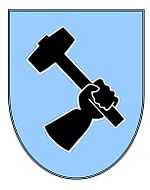Walter Bradel
| Walter Bradel | |
|---|---|
| Born |
31 July 1911 Breslau, now Poland |
| Died | 5 May 1943 (aged 31) |
| Buried at |
Ysselsteyn, Netherlands (Block CX, Row 4, Grave 85) |
| Allegiance |
|
| Service/branch |
Heer Luftwaffe |
| Years of service | 1934–43 |
| Rank | Oberstleutnant |
| Unit |
Condor Legion Kampfgeschwader 3 Kampfgeschwader 2 |
| Commands held | II./KG 2 |
| Battles/wars |
|
| Awards |
Spanish Cross in Silver with Swords Iron Cross First and Second ClassFront Flying Clasp of the Luftwaffe in Gold Honorary Cup of the Luftwaffe Knight's Cross of the Iron Cross |
Walter Bradel (31 July 1911 – 5 May 1943) was a Luftwaffe Bomber pilot and Geschwaderkommodore of KG 2 during World War II. He was also a recipient of the Knight's Cross of the Iron Cross (German: Ritterkreuz des Eisernen Kreuzes). The Knight's Cross of the Iron Cross was awarded to recognise extreme battlefield bravery or successful military leadership.
Luftwaffe career
Bradel joined the Heer in 1933, before joining the Luftwaffe. Bradel flew the Dornier Do 17 until 1942, and then the Dornier Do 217. Bradel was awarded the Knight's Cross on 17 July 1941 for his units particular effectiveness over the Grodno area, in which the Soviet 6th Cavalry Corps was routed, and lost 105 tanks.[1]
In 1943 Bradel's unit started flying bombing missions over England once more. During the night of 4 May 1943 to 5 May Angriffsführer England ordered a consolidated attack on Norwich. Involved were 43 aircraft from KG 2 under the command of Bradel, which took off from the airport of Soesterberg. The attack force was augmented by aircraft from II./KG 40 and 36 Ju 88 from KG 6. Bradel's Do 217K was attacked by a British nightfighter, and suffered engine damage. Pilot Leutnant Ernst Andres attempted an emergency landing near Landsmeer, Amsterdam. The aircraft was 80% damaged and Bradel was killed.[2] Walter Bradel is buried at the German Military Cemetery at Ysselsteyn, Netherlands (Block CX, Row 4, Grave 85)[3]
Awards
- Spanish Cross in Silver with Swords 6 June 1939
- Cruz de Guerra June 1939
- Iron Cross 2nd and 1st Class
- Front Flying Clasp of the Luftwaffe in Gold
- Ehrenpokal der Luftwaffe (30 July 1941)
- Knight's Cross of the Iron Cross on 17 September 1941 as Hauptmann and Staffelkapitän of the 9./KG 2[4]
References
- Citations
- Bibliography
- Bergström, Christer (2007). Barbarossa - The Air Battle: July–December 1941. London: Chervron/Ian Allan. ISBN 978-1-85780-270-2.
- Fellgiebel, Walther-Peer (2000). Die Träger des Ritterkreuzes des Eisernen Kreuzes 1939–1945 – Die Inhaber der höchsten Auszeichnung des Zweiten Weltkrieges aller Wehrmachtteile [The Bearers of the Knight's Cross of the Iron Cross 1939–1945 — The Owners of the Highest Award of the Second World War of all Wehrmacht Branches] (in German). Friedberg, Germany: Podzun-Pallas. ISBN 978-3-7909-0284-6.
- MacLean, French L (2007). Luftwaffe Efficiency & Promotion Reports: For the Knight's Cross Winners. Atglen, Pennsylvania: Schiffer Military History. ISBN 978-0-7643-2657-8.
- Scherzer, Veit (2007). Die Ritterkreuzträger 1939–1945 Die Inhaber des Ritterkreuzes des Eisernen Kreuzes 1939 von Heer, Luftwaffe, Kriegsmarine, Waffen-SS, Volkssturm sowie mit Deutschland verbündeter Streitkräfte nach den Unterlagen des Bundesarchives [The Knight's Cross Bearers 1939–1945 The Holders of the Knight's Cross of the Iron Cross 1939 by Army, Air Force, Navy, Waffen-SS, Volkssturm and Allied Forces with Germany According to the Documents of the Federal Archives] (in German). Jena, Germany: Scherzers Miltaer-Verlag. ISBN 978-3-938845-17-2.
- de Zeng, H.L; Stanket, D.G; Creek, E.J. (2007). Bomber Units of the Luftwaffe 1933-1945; A Reference Source, Volume 1. Ian Allan Publishing. ISBN 978-1-85780-279-5.
| Military offices | ||
|---|---|---|
| Preceded by Oberstleutnant Hans von Koppelow |
Commander of Kampfgeschwader 2 23 January 1943 – 5 May 1943 |
Succeeded by Oberstleutnant Karl Kessel |
| ||||||||
